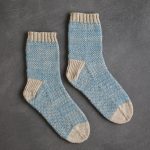Yarn Over (yo)
One of the easiest and most common ways to create an extra stitch in knitting is with a yarn over. Not only does this technique increase your stitch count by 1, yarn overs also leave you with a neat little eyelet that can be a decorative increase, an element in lacework, or even a buttonhole.
The most important thing to know about a yarn over is that it is simply the act of moving the working yarn from one place to another. It does not include the actual knitting or purling of a stitch. A yarn over creates a stitch only when you work the next stitch, but by itself, a yarn over does not make a stitch.
Here’s a video of how to work a simple yarn over between two knit stitches, as well as some slightly more complicated yarn over situations, followed by the same thing written out!
Between Two Knit Stitches
To work a yarn over between two knit stitches, bring the working yarn from the back of the work to the front by moving it between the two needles. Bring the working yarn over the top of the right needle as you knit the next stitch as usual. On the next row, that strand that came over the top of the needle will be worked as a normal stitch… And a stitch is born!
Two Yarn Overs In A Row, Between Two Knit Stitches
To work two yarn overs in a row, you bring the working yarn forward between the needles as you would for one yarn over, then wrap the yarn over the top of the right needle and bring it back forward between the needles again, in essence wrapping the yarn once around the right needle. As you knit the next stitch, the yarn will naturally wrap over the right needle again, making a second wrap (i.e. yarn over) on the right needle. On the next row, you will treat these wraps as two stitches.
Between Two Purl Stitches
To work a yarn over between purl stitches, all you have to do is bring the yarn from the front of the work (where it already is from having just purled) over the top of the right needle, then between the needles to the front of the work, ready to purl.
After A Knit + Before A Purl
To work a yarn over after a knit and before a purl stitch, bring the working yarn forward into the purl position. Next, bring the yarn over the top of the right needle, then between the needles to the front of the work, ready to purl.
After A Purl + Before A Knit
To work a yarn over after a purl and before a knit stitch, you simply leave the working yarn in the forward purl position, then knit the next stitch as usual. As you knit the stitch, the yarn will automatically come over the top of the right needle, creating a new stitch!
Remember!
A yarn over is just the act of moving the yarn, not the act of knitting or purling a stitch. What this means in real life is that when a pattern says, for example, “k3, yo, k3,” there are only 6 stitches to work, and you knit the first three, make a yarn over (i.e. bring the yarn forward between the needles), then knit the last three. Let us know if you have any questions and good luck with your yarn overs, wherever you meet them!





EXCELLENT VIDEO – this is the best YO video I’ve seen in years. I thought is was too long (5+ minutes), but going over YO between 2 purls, 2 knits, purl to knit, and knit to purl-I see where you need the 5 minute video – kudos to you
I enjoyed this a lot very informative.
Very helpful great job!
Thanks so much. Perfectly clear, I really appreciate it! (Seemed like I could never find the definitive answer to whether the yarnover should include the next stitch or not)
I can’t seem to find this tutorial…help, please
Hello, Christina!
Thank you so much for writing in! I am sorry that you’re having trouble finding the tutorial. Please give these links a try: https://www.purlsoho.com/create/2013/11/11/yarn-over-yo/ or https://www.youtube.com/watch?v=IRgNkX_M53g&noredirect=1
I hope these are helpful. If you have further questions, please let us know!
Happy knitting,
Kumeko
I can’t tell,you how much I appreciate this clear yo tutorial on all the ways to make a yarn over. I only really knew how to do a yo between knit stitches but I’m getting into lace knitting and have found book illustrations confusing, Kudos to PurlSoho for this!
Great tutorial — thanks!
I cannot say enough or too many times, how much I have loved your “how to” videos. They have all been very clear and to the point of how the stitch is done. Thank you so very much!!
Love your tutorial with all the types of YOs…however, as I am knitting the yarnovers, the K to P and P to P yarnover holes look much bigger than the P to K and K to K. Is there a technique that equalizes these for a better pattern look?
Hi Marsha,
Thanks for writing in. There is no way I know of to equalize the holes aesthetically. The reason that K-P and P-P yarn overs create bigger holes is that you are wrapping the yarn around the entire needle and not just the top of the needle. In using more yarn in your yarn over you will therefore have a larger hole. I hope this is clear!
Best,
Adam
Excellent video. So easy when you know how. This will be my next project.
Thanks Purl Soho and Laura for your wonderful yarnover tutorial. It has saved me on many occasions. Many thanks again. Hope you are having a nice summer.
Your tutorials are always helpful and directions concise and simple.
Great tutorial. Very helpful.
Great video. My pattern had both a YO between a knit and a purl, and,a YO between a purl and a knit. Crystal clear on this video. Loved it!
Brilliant!
Excellent video. I’m trying to learn lace knitting and the yarn overs are killing me! This video truly helps. THANK YOU!!
Hi Paula,
Thanks so much; we’re glad it helped!
Kindly,
Anna
Thanks so much for this tutorial! As a beginner to knitting, watching this video has been very helpful. I am just learning how to make my first washcloth, but look forward to tackling some of yoir lovely project patterns.
Best Wishes!
Thank you for this excellent video showing all 4 ways to do a yarn over. Your videos are the best! In one video you showed very clearly all we need to know about yarn overs!
Julie
Thank you for such a clear and informative introduction to yarn over – something I have struggled with when trying to knit lace. You have given me the impetus to try again!
Jude, London UK
Very clear.
You have the best video tutorials around.
Thank you!
Thank you so much for this video!!!!!!!!!!!
great. how do you do a double yo – as in the cattail wrap?
Hi Marny,
Great question! To work two yarn overs in a row, you will simply bring your yarn forward between the needles as you normally would for the first yarn over, then wrap your yarn over the top of the right hand needle and bring it back forward between the needles again to form the second yarn over. In essence, you will be wrapping the yarn twice around the right hand needle.
I hope that clears things up!
Julianna
Pattern K1yo every row – cast on is 98 stitches – will this pattern double each row for 2 skeins. Pattern is open air wrap in linen quill.
Hi Marguerite,
Thanks for reaching out! The pattern for the Open Air Wrap in Linen Quill is actually a bit different. You start by k1, but then you work *yarn over, followed directly by a purl 2 together, you then repeat from * till you reach the last stitch, knitting the last stitch. So you only k1 at the very beginning and the very end of the row.
So the number of stitches won’t actually change (it will stay 98 throughout the rows) as you work since you are both increasing (the yo) and decreasing (the purl 2 tog) in the row.
I hope this clears things up, please let me know if you have any other questions!
Gianna
Thank you, this is brilliant!
Could you please also share how to do a yarnover after an ssk where a pattern reads yo, ssk (slip two stitches knitwise, return to the left needle and knit both stitches together)
and
yo, sskpo (slip, slip, knit a stitch, pass the 2 slipped stitches over the one that has been knit)
Hi ZC,
Thanks for writing in! I am so glad to hear you enjoyed this tutorial! We don’t currently have the resources to create additional tutorials for the yo techniques, but thank you for expressing your interest! I will be sure to pass this along to the rest of the team. However, we do have an existing tutorial for the Slip Slip Knit Pass (s2kp) tutorial. You can also find our full library of tutorials here: Knitting Tutorials
I hope this helps, happy knitting!
Gianna
Guys, when I do a yarn over, that new stich on the backside row
looks like a noodle hanging in a wire grid.
How do I tighten it up?
Hi KJ,
Thanks for writing in! That actually sounds just about right for a yarn over, so I think you’re doing everything correctly! The stitch may take a few rows to even out its tension. If you’re still worried that your work doesn’t look quite right, I’d recommend sending a photo to customerservice@purlsoho.com, so we can take a look!
All the best,
Lili